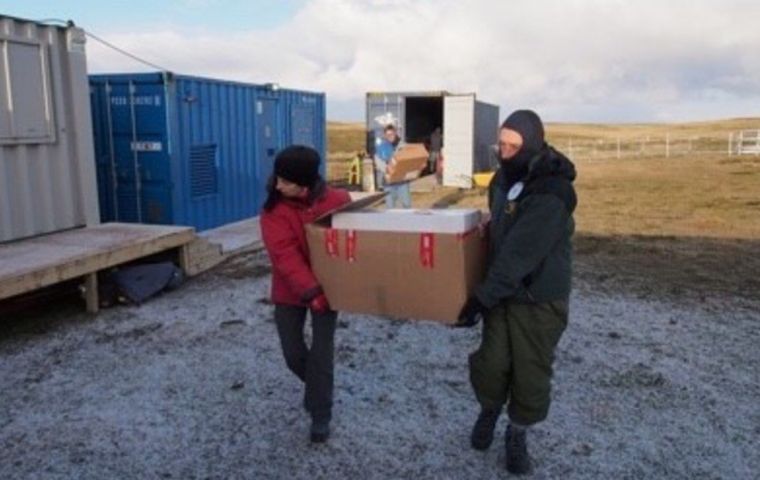MercoPress. South Atlantic News Agency
Genetic material of Argentine 1982 combatants lands in Córdoba for DNA testing
 The DNA tests may take between two and three weeks, it was reported.
The DNA tests may take between two and three weeks, it was reported. Argentine forensic anthropologist Luis Fondebrider, at the service of the International Committee of the Red Cross (ICRC), Thursday landed in Córdoba in a private flight from the Falkland Islands carrying genetic material to be used in determining the identity combatants buried in grave C.1.10 at Darwin's military cemetery.
The samples are to be analyzed at the Argentine Forensic Anthropology Team's (EAAF) local laboratory to help link those remains to the actual names of the five Gendarmeria Nacional Alacrán Group commandos killed when their Puma helicopter was downed by a British missile on May 30, 1982, over Mount Kent.
The DNA tests may take between two and three weeks, it was reported.
The Lear Jet aircraft first flew from the San Fernando airport north of Buenos Aires to Mount Pleasant carrying the tombstones for soldiers Néstor Osvaldo Pizarro, Ramón Antonio Meza and Juan Carlos Baldini. Their bodies had been identified in 2019, but pandemic restrictions prevented their graves to be properly named until now.
Fondebrider, founder and former director of the Argentine Forensic Anthropology Team (EAAF), was also a part of the Humanitarian Project Plan involved in the identification of the Argentine soldiers buried as “only known to God” in the Darwin cemetery since 2017.
Grave C1.10 should have been reopened then, but it was not because since 2004 it had names on it. Wrong names, which kept it off-limits to the 2017 mission as per the December 2016 agreement among the governments of the United Kingdom, Argentina, the Falkland Islands and the International Committee of the Red Cross (ICRC).
ICRC mission leader Laurent Corbaz had announced last week that the human bones found in grave C.1.10 were in a good state for DNA material to be obtained and MercoPress sources have established relatives of every crew member of the doomed aircraft had supplied samples for testing, despite which Fondebrider warned: “five bodies don't always mean five names.”
In 1983, British Colonel Geoffrey Cardoso and his team established Gendarmeria Second Lieutenant Ricardo Sánchez was one of the dead, thanks to an ID card. In 2004 the names of Héctor Walter Aguirre, Mario Ramón Luna, Julio Ricardo Sánchez and Luis Guillermo Sevilla were mistakenly added.
When three of them were found in 2017 through DNA testing to be buried in individual graves, the issue of who the remains belonged to came back into the spotlight. Hence the new humanitarian project.
The private flight was supported by Argentine businessman Eduardo Eurnekian.
“The work allows us to certify that there are at least five bodies and not four as had been pointed out in 1983, which does not discredit the extraordinary work carried out by British Colonel Geoffrey Cardozo when he collected the bodies of Argentine soldiers from the battlefields. and he created the cemetery since 39 years ago it was carried out by military personnel and not by scientists and after the bodies were left in the open for three months,” said Fondebrider.




Top Comments
Disclaimer & comment rules-

-

-

Read all commentsWorthwhile yes, however incomplete.
Aug 28th, 2021 - 04:18 pm +2Once the bodies are identified they are being re-interred in the Falklands instead of being buried in Argentina, or at sea if they continue to insist they are already buried in Argentina.
I can't help thinking this is simply creating a problem for the future.
A very worthwhile project and well executed. Let’s hope some more families finally know for sure where their lost loved ones rest.
Aug 28th, 2021 - 03:13 pm +1Credit to Eduardo Eurnekian for continuing to support this cause.
@Pugol-H
Aug 30th, 2021 - 01:30 pm 0Clearly. The problems must be definitively solved. Leaving problems, the Falklands/Malvinas issue in this case, abandoned “on one side getting dirt” does not imply solving them but rather leaving them pending solution for the future.
Either the issue gets solved or it will be a “headache” for future generations. Anyway, based on the lack of progress on this issue, our generation, clearly, is responsible for. I hope future generations might be skilled enough to find a solution. We failed.
Commenting for this story is now closed.
If you have a Facebook account, become a fan and comment on our Facebook Page!